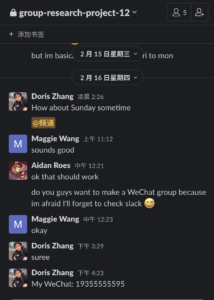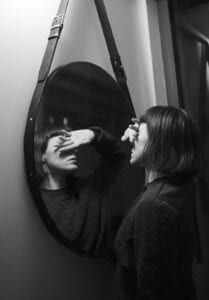1. Why mirror?
Great minds think alike

Our group was first formed in Slack, then we switched to WeChat. We worked together with extremely high efficiency. After the self-introduction and sharing our “inventions” for the three stories, we finalized two ideas for our group project:
-
-
- A giant nanny robotic goose from The Veldt.
- A mirror that slowly shows the viewer as the child in the room from The Ones Who Walk Away from Omelas.
-
We voted. And the result was that we chose the mirror. Sean expressed his concern about our crafting skills to make a mirror that looks like a mirror, which is a challenge.

We decided to focus on our performance to make the audience believe this is a “mirror.” Soon, with ideas from Michelle, Maggie, Sean, and me, we formed a general script draft and sighed up for characters.
Mirror and Interactivity
As stated in the first research assignment. I define “interactivity” as:
A mutual activity with meaningful information exchanged between two minds or more (designers, computers, audience, users, etc.) with minimal interference from other external forces.

Though sometimes a mirror is perceived as an “old-school” artifact, and it is true that according to an archaeological finding, the first mirror in human history dates back as far as 4000 BCE, a mirror is a good invention with a high level of interactivity. As a vehicle of interaction and s tool in our daily life. People use it simply by standing in front of it, and seeing their own reflections in the mirror. From this process, I see a loop: the viewer shows up at the mirror → reflection is formed → reflection is perceived by the viewer → the viewer makes changes to their movement/gestures/appearance → new reflection is formed → … A simple mirror is an artifact that realizes interactivity with a single subject. However, our “carnival mirror” does not only reflect the views, but also projects the “miserable kid.” Thus, more “meaningful information” is exchanged, and young people from Omelas could be woken up by this mirror and leave the city to find the true essence of life.
One thought on “Carnival Mirror – Group Research Project”